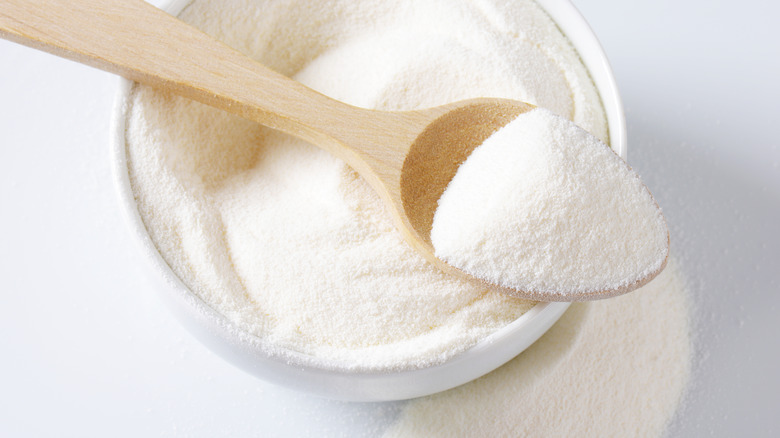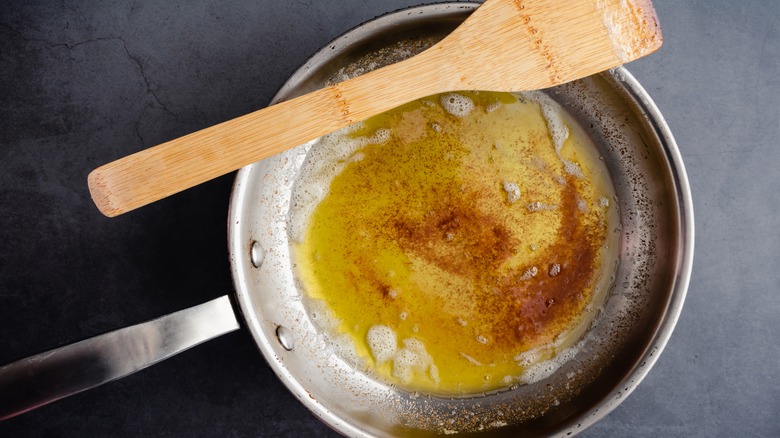The Difference Between Regular And Toasted Milk Powder Is All In The Taste
Most people keep milk powder on hand as a go-to for having milk available at a moment's notice, without having to check if the carton in the fridge has soured yet. But something that has gained popularity is the practice of toasting your milk powder. The difference between regular milk powder and toasted milk powder is that one tastes like milk, and the other tastes like brown butter.
Milk powder — also known as powdered milk or dried milk — tastes just like milk when reconstituted with water: It's creamy, subtle, and a bit sweet. Really, it is just milk: It's fresh milk that's been dehydrated fully into a powder. By toasting it, the milk solids go through exactly the same process as they do when you brown butter, and therefore it takes on that same flavor. Rather than being subtle and creamy, it develops a deeper, more complex flavor profile, with warm toffee, caramel, butterscotch, and nutty notes. And it will impart that flavor into anything you add it to.
How toasted milk powder gets its flavor
Milk powder can be toasted in a few different ways: in an oven, in a pan on the stovetop, or by adding it to melted butter you're about to brown for an extra flavorful brown butter hack. But how does it work?
Milk powder — like the milk solids in brown butter — is made primarily of protein like casein and milk sugars like glucose and lactose (and, depending on whether you're working with non-fat or full-fat milk powder, milkfat). These are the exact compounds that are affected by the Maillard reaction, which is responsible for the browning of bread, meat, and yes, butter. The amino acids in the protein and the sugars in the lactose undergo a chemical reaction between 285 degrees and 330 degrees Fahrenheit, creating hundreds of flavor compounds.
When browning butter, the emulsion unravels: Milkfat melts, milk solids fall out of suspension, and water evaporates. With the water gone, it can get up past 212 degrees and the milk solids hit the Maillard temperature range, beginning to brown. By toasting milk powder, you're skipping right to that last step. It's the same browned milk solids as browned butter, but without the butter. You're still creating all of those flavor compounds.
Use toasted milk powder to amp up flavor
Once you have toasted milk powder, you can use it to boost the flavor of anything that calls for brown butter — and things that don't. Not everything should have brown butter added to it, but you can use toasted milk powder to bring the flavor. Take whipped cream, for instance. You can't really add butter to whipped cream and still have whipped cream. But you can add toasted milk powder, which adds a boost of flavor and has the benefit of stabilizing your whipped cream.
You can also add toasted milk powder to your coffee for a brown butter morning coffee, or add it to your milk (dairy, almond, oat, your choice — just remember it won't be lactose-free!) for a brown butter latte. Kelly Mencin, a Brooklyn pastry chef, told Martha Stewart that she uses milk powder in a number of applications. Adding milk powder to bread dough helps it ferment, and adding toasted milk powder adds a flavor complexity. Adding milk powder to homemade ice cream makes it "denser and smoother," Mencin claims — and toasting it would, of course, give you a deeper flavor. Adding milk powder to cookie dough makes the cookies chewier, and toasted milk powder would give the cookies a brown butter flavor without going through the hassle of waiting for browned butter to firm up enough to cream it. It's a win-win.


